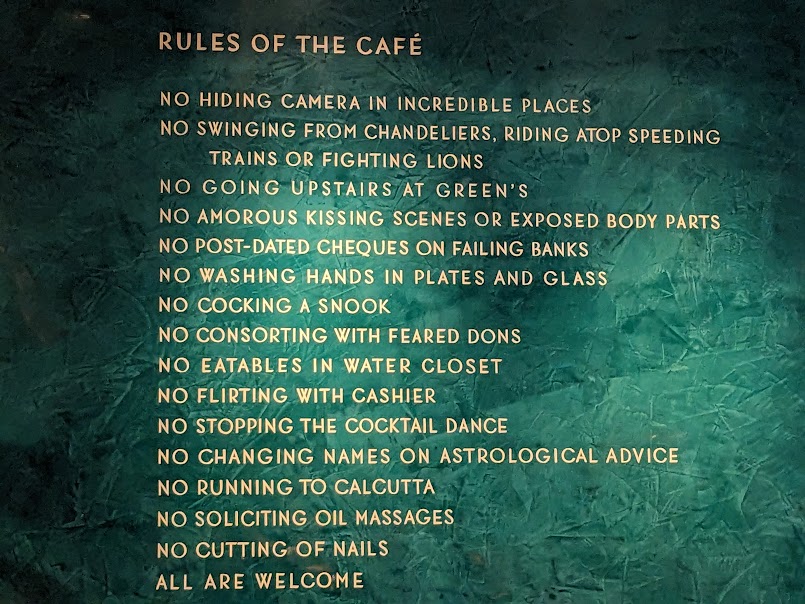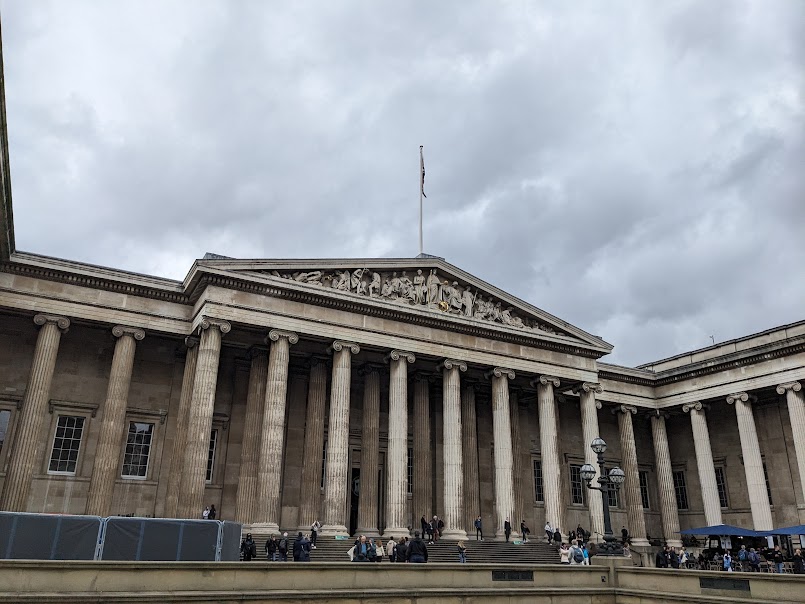Yesterday 16k quad burning thigh destroying steps, so naturally there is no time to rest we gotta go see London again. Since the breakfast place we wanted to go with the kids doesn't open until later, Michelle and I woke up early. Just to get an extra walk in.
London is a layered city, history built on top of history paved over by chain shops and the few independent bars. The city is always in motion, sure that place used to be where Jane Austen visited every summer for two years but now it's a kicky local spot for drag shows! People still need to make a living, bring their wares and food and experiences to the public. There is simply too much history on top of history to stop and notice it too much.
It's a intergridlocked set of past, far past, present, far future all roiling ever forward. And that's not even the most confusing thing about the city.
In Vancouver, you get a sense of the geography: the mountains, the water, the rolling hills always give you a sense of place. That and most of the roads mainly run east west and north south. In London, there are no mountains, everything is relatively flat (although there are rivers, of course). But worst of all is the streets that have grown over ancient creeks and rivers and some lord's land which encroached upon some other fief or whathave you. All roads seem to curve. I've never looked down so many streets and see it END, in a building, or structure, a jaunty long forgotten Templar hideout. Now, no one would ever call me a natural navigator, but I get turned around very quick in London. There is so much interesting detail in every street it becomes very difficult to get your bearings, or, for me to get my bearings.
I can honestly say that if there wasn't Google maps, best app on my phone, I'd seriously reconsider ever visiting London. It would be like that movie "The Terminal", but instead of an airport it's a city and instead of a charmingly befuddled Tom Hanks it'd be an exasperated middle aged programmer just wondering why he's been lost in the same 2 square kilometres for 30 years.
We stroll through Trafalgar Square, and the immensity of the monuments and buildings around it are always impressive. But it strikes me how much of all these institutions are really the bones of a dead empire. Still, the roots (for good or for bad) for so many democracies; but in the end bones, more or less, when compared the behemoth of the U.S..
Post 911 (I think we are post post post 911 by now, but I digress) there seems to be a real dearth of garbage cans. There is one in front of Trafalgar square, I toss my coffee cup, and the missus thinks she'll just toss it in the next one she crosses. We walk to the Admiralty, Horse Guards, St James Park, Big Ben, and back to the Admiralty and, well, she ends up tossing her cup in the same can I used. Now that I list our route, I realize how close to all the key government buildings those all are, so I suppose it makes sense. If you are more interested in national security than say, making it slightly more convenient for tourists to throw away their empty coffee cups.
The Admiralty was my highlight. You can see almost none of it, as it's behind a high security fence. But it's much the same as it was in the Napoleonic era, there is the fouled anchor that is featured so prominently in Patrick O'Brian's work, such a amazing thing to see. For a kind of history buff. I'm very interested in that narrow set of history that the 20 books cover, the rest, not so much. I take a picture of it, of course, naive Canadian that I am, my wife mentions that a police man is watching me because literally nobody stops in front of the Admiralty OR reads the two lovely plaques. Luckily I wasn't tased or carried away. Its too much to ask, but it would be nice if they had a cordoned off area that nerds such as myself could have access to which references the Napoleonic era and in no way has anything to do with modern operations. Apparently the war room is still used on occasion.
So we have our small tour of all the highlights and make our way back to our kids who are still likely sleeping, relaxing away. We've just hit 10k steps.
From there we make our way to the British Museum. Another world famous landmark. It has uncomfortable notions of being the result of Just Really Posh Pirating. This is not something acknowledged much, but that is certainly the undercurrent. Many pieces you can sort of squint and look at it sideways and think 'well, ok, I guess that's ok?'. Some come from countries that have since put up (rightfully) strict barriers for extraction of their treasures and have museums in their own right.
The Egyptian area was, of course, awe inspiring, the first thing you see is the Rosetta Stone.THE Rosetta stone. Or at least I couldn't get close enough to see if it was a reproduction of it. That's quite the first impression. But the rest of antiquity kinda leaves me loopy. Mainly because I have no sense of a contiguous story. In the Egypt area there are just random statues and bits of statues with a plaque that talks about some era in history where this pharoah took over from this pharoah but defaced this statue, etc etc.And then the next statue will be about some other era entirely. The same as we wander into Ancient Greece: here is a tomb from long ago that we are still holding onto, and it's related to this other set of information which might be interesting if you were into Ancient Greece as a whole. And I've established my intersthistory only covers about 20 years, and a few centuries after this.
My son had a grand time, reading about all these things, reading up the plaques like a champ. My daughter is a, as she puts it, a 'professional sitter', so she's always on the lookout for a bench to sit and chill. He takes the lead and pulls across the museum, willy nilly, but of course, his real concern is to find some pretty rad armour and weapons. I can't say this doesn't pique my interest. Thousands of steps later we find one sword, a ceremonial two hander, but we still gave the fist pump of victory when we found it.
 |
| This is NOT the sword I was talking about, but forsome reason we forgot to take a picture over our fistbumps? |
The idea of stolen artifacts comes to the fore when we find the Moai statue, from Rapa Nui. It's an impressive Easter Island head, carved from an unusual material. I think because it was unusually significant.I read a plaque on the BACK, where it looks like maybe the folks from Rapa Nui had paid it a visit, maybe sometime in the 90's. But the text is something else, more or less "the people of Rapa Nui would like this most sacred object back.. we are still in discussion about that (dated 2019)". Now, I'm not saying this makes the British Museum look bad, but it doesn't exactly make them look real great either. Maybe there is nuance to anthropology or.. museumology... I"m not aware of. But if the original folks want their priceless cultural treasure back, maybe they should just have it back, but I'm just a lay person who just learned today that Byzantium empire sprouted up AFTER the Roman Empire (how did they even let me in, I know you are wondering).
We then finally make our way up to the Japanese exhibit, which is in a far corner up far too many steps. It's minimalist, but very interesting. I had just finished that best seller novel Shogun, so felt really up to speed on medieval Japan as imagined by an Australian in the 60s. It was all brought to life, the tea houses, the tatamis. and, in the centre of it all, a real samurai armour set with the katana and tanto. What struck me most about the exhibit was not just all the old and modern artifacts, but how often there was a note on the plaque "this is a replica, the original is a natural treasure kept in Japan". It feels like the world has eventually gotten wise to the British Museum's procuring ways: 'fool me 27 times, shame on me...'.
We finish the day just edging over 16k steps again, and make our way back to the hotel in one piece, guided, ever so deftly by Google maps.









Comments